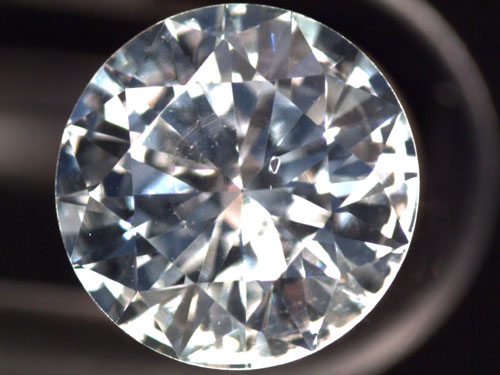A synthetic diamond has been identified by the DCLA, on the heels of the recent discovery of numerous treated diamonds in Australia.
The man-made diamond, a near-colourless 0.54ct round brilliant cut diamond, was submitted to the DCLA Laboratory for authentication by an Australian diamond merchant unconfident of its origin.
With subsequent examination, the diamond was identified by the DCLA as a diamond created by a company in Canada, Advanced Optical Technologies Corporation (AOTC). Identifying features of this diamond include no fluorescence and a light blue hue, as well as a tiny dark grey inclusion with metallic lustre, pictured above at high resolution 50X magnification.
AOTC produces synthetic coloured diamonds (primarily yellows and blues) as well as colourless “white” diamonds using a high-pressure high-temperature (HPHT) process. There are several other overseas companies also producing synthetic diamonds on a wide scale using this process, while others use a newer process using chemical vapour deposition (CVD) technology. To date, however, there has been no fully disclosed importer of synthetic diamonds in Australia.
In terms of identification, synthetic diamonds (also known as man-made diamonds, lab- or laboratory-created diamonds, and lab- or laboratory-grown diamonds), have the same chemical, physical, and optical properties as natural diamonds do, making them impossible to identify without advanced testing.
Examination with a microscope may sometimes show indicators, or ‘clues’, that a diamond is synthetic, but these are indicators only; neither presence nor absence of these indicators is conclusive. Both natural diamonds and synthetic diamonds may show very similar characteristics, thus advanced testing is required for conclusive identification.
Some visible clues of synthetic diamonds that valuers should be aware of are those of dark grey or black inclusions with a metallic lustre, as seen in this particular HPHT-created diamond, inert fluorescence under long-wave UV light, cloud inclusions, internal or surface graining, stronger short-wave to long-wave fluorescence, phosphorescence, and colour zoning, among others. Natural diamonds will also show these characteristics however, which is why identification of a diamond’s origin requires an educated and trained gemmologist, skilled in handling the necessary equipment in a qualified laboratory.
Buyers and valuers should also be aware that synthetic diamonds created by synthetic diamond producers like AOTC are laser inscribed on the girdle for identification and disclosure purposes, ie. “AOTC CREATED” and should be accompanied by a synthetic diamond report for full and clear disclosure – however, this inscription can be removed and a diamond should always be verified.
DCLA will not issue diamond grading certificates for synthetic diamonds.
